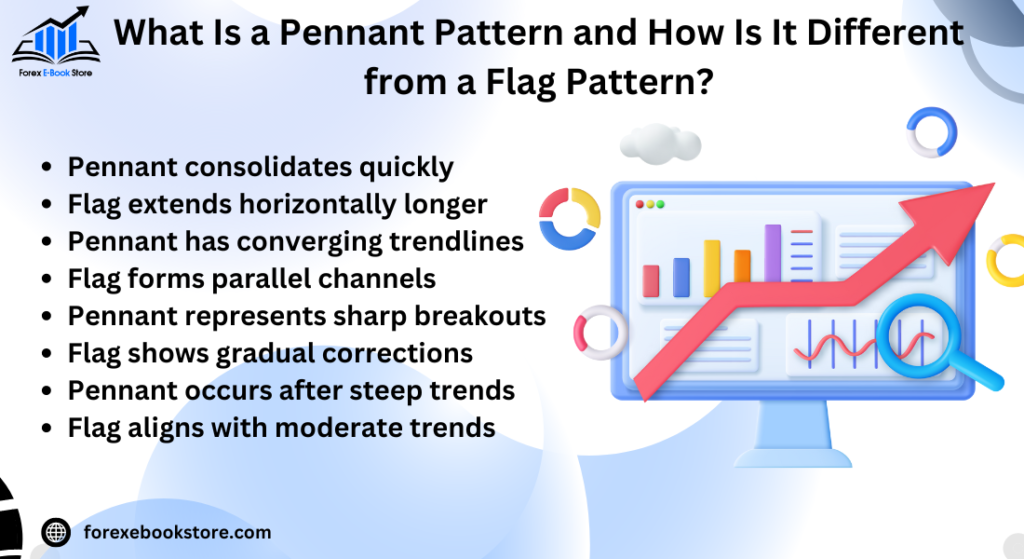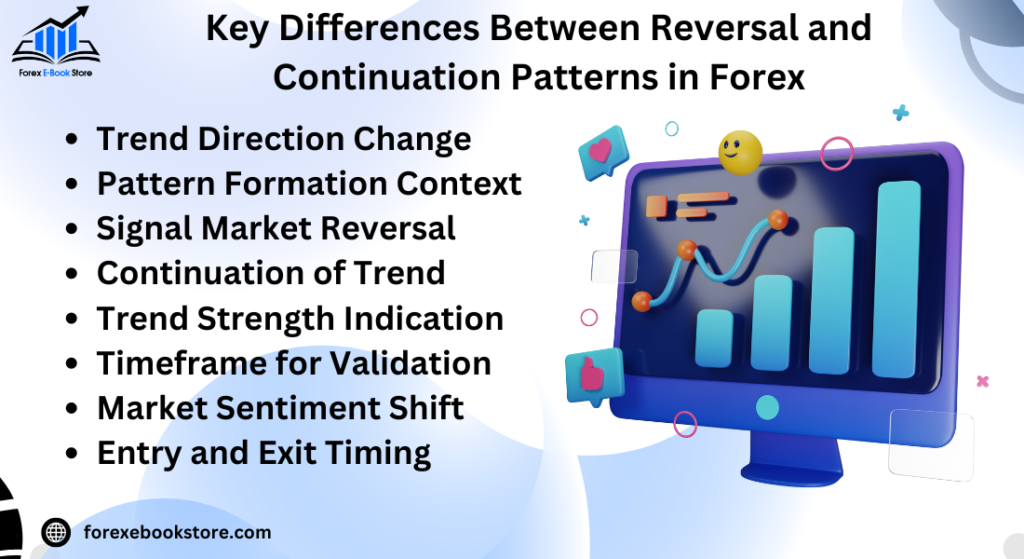In the world of Forex trading, understanding chart patterns is crucial for making informed decisions. Common Forex chart patterns are visual formations created by the price movements of currency pairs over time. These patterns help traders identify potential market trends and reversals, offering valuable insights into future price action. By mastering these patterns, traders can anticipate market movements and execute trades with more confidence.
There are several chart patterns that are frequently used in Forex analysis, ranging from simple formations like double tops and double bottoms to more complex patterns like head and shoulders or ascending triangles. Recognizing and interpreting these patterns can provide a significant edge in trading, as they often serve as early indicators of bullish or bearish trends. Understanding the intricacies of these Forex chart patterns can be the difference between a profitable trade and a missed opportunity.
Table of Contents
How Do Reversal Chart Patterns Work in Forex Trading?
Reversal patterns in Forex indicate a change in the direction of the market trend, signalling the potential end of the current trend and the beginning of a new one. Recognizing these patterns helps traders identify when a bullish market is about to turn bearish, or vice versa.
Key Reversal Patterns in Forex:
- Head and Shoulders Pattern: This pattern is one of the most reliable indicators of a trend reversal. It forms when a peak (head) is flanked by two smaller peaks (shoulders), signalling a shift from a bullish to a bearish trend.
- Double Top and Double Bottom: These patterns are common reversal signals. A double top forms after an uptrend and signals a potential bearish reversal, while a double bottom forms after a downtrend and suggests a bullish reversal.
How to Use Reversal Patterns in Trading:
- Identify Entry and Exit Points: Traders can use these patterns to pinpoint the best times to enter or exit a trade. For instance, when a head and shoulders pattern completes, it’s often a good time to sell.
- Confirm with Technical Indicators: Before making a move, traders should confirm the reversal pattern with other technical indicators like moving averages or RSI to increase the likelihood of a successful trade.
What Are the Most Common Continuation Patterns in Forex?
While reversal patterns signal a change in trend direction, continuation patterns indicate that the current trend is likely to continue after a brief consolidation phase. These patterns provide traders with opportunities to capitalize on the ongoing trend.
Key Continuation Patterns in Forex:
- Bullish and Bearish Flags: Flag patterns form after a sharp price movement, followed by a period of consolidation. A bullish flag indicates the continuation of an upward trend, while a bearish flag signals a continuation of a downtrend.
- Pennant Pattern: Similar to the flag pattern, the pennant forms after a strong price move, but the consolidation takes the shape of a small triangle. Pennants often indicate that the price will break out in the direction of the previous trend.
How to Use Continuation Patterns in Trading:
- Set Target Prices: Traders often use flag and pennant patterns to set profit targets. Once the price breaks out of the pattern, the expected move is usually equal to the size of the initial price movement.
- Use Volume for Confirmation: Higher trading volume during the breakout confirms the strength of the continuation pattern, making it more reliable.
How Can You Identify a Head and Shoulders Chart Patterns in Forex?
The head and shoulders pattern is one of the most well-known reversal patterns in Forex trading, indicating a potential shift from an uptrend to a downtrend. It is characterized by three peaks: the highest peak in the middle (the head), and two smaller peaks on either side (the shoulders).

Steps to Identify a Head and Shoulders Pattern:
- Left Shoulder: The market experiences an upward movement, reaches a peak, and then declines to form the left shoulder.
- Head: The price rises again, surpassing the previous peak to form the head, and then declines once more.
- Right Shoulder: The price rises a third time but fails to reach the height of the head, forming the right shoulder before falling again.
How to Trade the Head and Shoulders Pattern:
- Neckline Break: The neckline, which connects the lows of the two troughs between the shoulders and the head, serves as a critical level. When the price breaks below the neckline, it confirms the pattern and signals a selling opportunity.
- Stop-Loss and Target Setting: Traders typically place a stop-loss above the right shoulder to limit risk and set a target based on the height of the pattern, from the head to the neckline.
What is a Double Top and Double Bottom Pattern in Forex?
The Double Top and Double Bottom patterns are classic reversal formations that signal a potential change in the market trend. These patterns are widely used by Forex traders to identify market tops and bottoms, offering valuable opportunities to enter or exit trades at the right time.
Double Top Pattern
A double top occurs after a strong uptrend, indicating a possible shift to a downtrend. It consists of two distinct peaks at roughly the same price level, with a pullback in between.
- Formation: The price rises to a peak, pulls back, rises again to a similar level as the first peak, and then declines, forming the double top.
- Bearish Signal: When the price breaks below the support level formed by the pullback between the two peaks, it signals a potential downtrend, offering a sell opportunity.
Double Bottom Pattern
A double bottom forms after a downtrend and signals a potential bullish reversal. It consists of two lows at roughly the same price level.
- Formation: The price drops to a low, rises slightly, drops again to the same low, and then rebounds.
- Bullish Signal: When the price breaks above the resistance level formed between the two lows, it confirms the reversal, signaling a buy opportunity.
How to Trade Double Top and Double Bottom Patterns:
- Neckline Break: For both patterns, the break of the support (double top) or resistance (double bottom) level is the critical entry signal.
- Target Price: The expected price movement after the breakout is typically equal to the height of the pattern, from the peak to the support or from the bottom to the resistance.
How to Trade with a Bullish and Bearish Flag Pattern in Forex?
The flag pattern is a common continuation pattern in Forex trading, signaling that the current trend is likely to continue after a brief period of consolidation. Bullish flags indicate the continuation of an upward trend, while bearish flags suggest the continuation of a downtrend.
Bullish Flag Pattern
A bullish flag forms when the price experiences a steep rise followed by a period of consolidation that takes the shape of a flag.
- Formation: The price surges upward (flagpole), then moves in a tight, downward-sloping range (the flag).
- Bullish Continuation: A breakout above the upper trendline of the flag signals that the uptrend is likely to continue, providing a buying opportunity.
Bearish Flag Pattern
A bearish flag occurs after a sharp downtrend and indicates a continuation of the downward movement.
- Formation: The price drops sharply (flagpole), followed by a brief period of consolidation that forms a small upward channel (the flag).
- Bearish Continuation: A breakout below the lower trendline of the flag signals the resumption of the downtrend, offering a selling opportunity.
How to Trade Bullish and Bearish Flags:
- Entry Point: Traders typically enter a trade when the price breaks out of the flag’s trendline, confirming the continuation of the previous trend.
- Target Price: The potential move after the breakout is often equivalent to the height of the flagpole, providing clear price targets for profit-taking.
What Is a Pennant Pattern and How Is It Different from a Flag Pattern?
The Pennant pattern is another continuation pattern in Forex that signals the continuation of the current trend. While similar to the flag pattern, the pennant is characterized by converging trendlines that form a small symmetrical triangle, rather than the parallel trendlines seen in flags.

Pennant Pattern Formation
The pennant forms after a strong price movement, followed by a brief period of consolidation where the price moves within a small triangle before breaking out in the direction of the previous trend.
- Bullish Pennant: Forms after a sharp upward price movement. The pennant signals that the market is taking a short breather before continuing the uptrend.
- Bearish Pennant: Occurs after a steep downward move, indicating a brief consolidation before the downtrend resumes.
How It Differs from a Flag Pattern:
- Shape: A flag pattern has parallel trendlines, while a pennant has converging trendlines, forming a triangle.
- Consolidation Time: Pennants usually form over a shorter period compared to flag patterns, and the consolidation is typically tighter.
- Breakout Direction: Like the flag, the breakout from the pennant tends to occur in the same direction as the preceding trend, but the pennant’s triangular shape can sometimes confuse traders who expect a symmetrical triangle pattern instead.
How to Trade Pennant Patterns:
- Entry: Traders typically enter a trade after the price breaks out of the pennant formation, confirming the continuation of the trend.
- Target Price: The price target is often equal to the size of the initial move (flagpole) leading up to the pennant, helping traders set realistic profit goals.
How to Use the Ascending and Descending Triangle Patterns in Forex Trading?
Triangle patterns are essential for Forex traders, as they provide clear signals about potential breakouts. Ascending and descending triangles are both continuation patterns, but their implications are different depending on whether they form in a bullish or bearish market.
Ascending Triangle Pattern
An ascending triangle is a bullish continuation pattern that occurs when the price makes higher lows while hitting resistance at the same level, forming a flat top and an upward-sloping bottom.
- Formation: The upper trendline is horizontal, representing resistance, while the lower trendline slopes upward, showing that buyers are gaining strength.
- Bullish Breakout: The breakout typically occurs above the resistance level, signaling a strong upward continuation of the price trend.
Descending Triangle Pattern
A descending triangle is a bearish continuation pattern that forms when the price makes lower highs but finds support at the same level, creating a flat bottom and a downward-sloping top.
- Formation: The lower trendline is horizontal, representing support, while the upper trendline slopes downward, indicating selling pressure is increasing.
- Bearish Breakout: A break below the support level signals a likely continuation of the downward trend, providing a selling opportunity.
How to Trade Triangle Patterns:
- Wait for Breakout: Traders typically wait for a clear breakout from the triangle pattern, either above the resistance (ascending) or below the support (descending).
- Volume Confirmation: Look for increasing volume during the breakout to confirm the strength of the price movement, which helps avoid false breakouts.
What is a Symmetrical Triangle Pattern and How Can It Signal Market Movements?
The symmetrical triangle is another powerful continuation pattern seen in Forex trading. Unlike ascending or descending triangles, the symmetrical triangle forms when neither buyers nor sellers have control, creating a neutral pattern where both trendlines converge toward the apex.
Symmetrical Triangle Formation
A symmetrical triangle forms when the price makes lower highs and higher lows, resulting in two converging trendlines. This pattern reflects market indecision, where the price is preparing for a breakout in either direction.
- Neutral Setup: The symmetrical triangle doesn’t inherently indicate a bullish or bearish breakout. The direction of the breakout depends on the prevailing trend.
- Breakout Timing: As the price nears the apex of the triangle, traders anticipate a strong breakout either upwards or downwards, following the direction of the prior trend.
How to Trade the Symmetrical Triangle:
- Monitor the Breakout: Once the price breaks out of the triangle, traders should enter the trade in the direction of the breakout, as this usually signals a continuation of the previous trend.
- Target Price: The expected price movement after the breakout is typically equivalent to the widest part of the triangle, helping traders set profit targets.
Why Symmetrical Triangles Matter:
- Versatility: Symmetrical triangles can appear in both bullish and bearish markets, making them useful for any trading environment.
- Potential for Strong Moves: The consolidation before the breakout often leads to significant price movements, especially if the breakout is confirmed by strong volume.
How to Identify a Wedge Pattern in Forex and What Does It Indicate?
Wedge patterns in Forex are key reversal or continuation patterns that indicate a potential change in the price trend. There are two types of wedges: rising wedges and falling wedges. Both patterns are characterized by converging trendlines and a narrowing price range, signaling that the market is preparing for a breakout.
Rising Wedge Pattern
A rising wedge forms when the price makes higher highs and higher lows, but the slope of the highs is less steep than the slope of the lows, resulting in a narrowing wedge shape. This is typically a bearish pattern, signaling a potential downtrend.
- Bearish Reversal: A rising wedge that forms after an uptrend suggests that buyers are losing momentum, and a bearish reversal is likely once the price breaks below the lower trendline.
- Bearish Continuation: In some cases, a rising wedge can also form during a downtrend, signaling that the downtrend will continue after a brief rally.
Falling Wedge Pattern
A falling wedge occurs when the price makes lower highs and lower lows, but the slope of the lows is steeper than the slope of the highs, creating a narrowing pattern. This is generally a bullish pattern, indicating a potential upward reversal.
- Bullish Reversal: A falling wedge that appears after a downtrend often indicates that selling pressure is waning, and a bullish reversal may occur once the price breaks above the upper trendline.
- Bullish Continuation: When a falling wedge forms during an uptrend, it suggests that the uptrend will resume after a brief correction.
How to Trade Wedge Patterns:
- Entry Point: Traders typically enter a trade when the price breaks out of the wedge pattern. For a rising wedge, this would be a break below the lower trendline, while for a falling wedge, it would be a break above the upper trendline.
- Stop-Loss and Take-Profit: It’s important to place a stop-loss order just above or below the wedge to limit risk. The target price is often set based on the height of the wedge, measured from the widest part of the pattern.
What Are the Key Differences Between Reversal and Continuation Patterns in Forex?
Understanding the key differences between reversal and continuation patterns is essential for traders who want to accurately predict market behavior. While both pattern types are important, they signal entirely different market actions, and knowing when to recognize them can significantly impact trading decisions.

Reversal Patterns
Reversal patterns signal a change in the prevailing trend, indicating that the market is likely to shift direction. These patterns typically appear at the end of an uptrend or downtrend.
- Examples: Common reversal patterns include head and shoulders, double tops, double bottoms, and rising and falling wedges.
- Market Signal: A reversal pattern suggests that the current trend is losing momentum, and the price is likely to move in the opposite direction. For instance, a head and shoulders pattern forming after an uptrend indicates an impending downtrend.
Continuation Patterns
Continuation patterns suggest that the current trend will continue after a brief consolidation period. These patterns offer traders an opportunity to enter trades aligned with the prevailing trend.
- Examples: Common continuation patterns include flags, pennants, and ascending/descending triangles.
- Market Signal: A continuation pattern indicates a temporary pause in the trend, but the price is likely to resume in the same direction. For example, a bullish flag during an uptrend signals that the price will continue to rise after the consolidation.
Key Differences:
- Purpose: Reversal patterns indicate a trend change, while continuation patterns confirm that the trend will persist.
- Timing: Reversal patterns occur at the end of a trend, while continuation patterns happen in the middle of a trend.
How Do You Trade Using the Cup and Handle Pattern in Forex Markets?
The cup and handle pattern is a bullish continuation pattern that appears in Forex markets when the price forms a U-shaped curve (the cup), followed by a small consolidation or pullback (the handle). This pattern signals that the price is likely to break out upward after the handle is completed.
Cup and Handle Pattern Formation
- Cup: The price declines, forms a rounded bottom, and then rises back to the previous high, creating the shape of a cup.
- Handle: After the cup, the price consolidates in a small channel or forms a slight pullback, creating the handle.
How to Trade the Cup and Handle Pattern:
- Entry Point: Traders typically enter a trade when the price breaks out above the handle, confirming the continuation of the uptrend.
- Stop-Loss: Place a stop-loss order just below the handle or the low point of the cup to manage risk.
- Profit Target: The target price is often set by measuring the depth of the cup and projecting that distance upward from the breakout point.
Why the Cup and Handle is Reliable:
- Bullish Continuation: This pattern is highly reliable in predicting an upward breakout, especially when confirmed by increasing volume during the breakout.
- Length of Pattern: The longer and more rounded the cup formation, the stronger the expected breakout.
What Are the Most Reliable Chart Patterns for Short-Term Forex Traders?
Short-term traders focus on quick market movements, and some chart patterns are particularly reliable for capturing fast, profitable trades. The most reliable patterns for short-term Forex traders are those that signal imminent price movements and provide clear entry and exit points.
1. Flags and Pennants
Flags and pennants are among the most effective patterns for short-term trading, as they signal quick continuation of the current trend after a brief consolidation.
- Quick Breakouts: These patterns often result in rapid price breakouts, making them ideal for short-term trades where timing is critical.
- Profit Target: Short-term traders can set clear profit targets by measuring the flagpole and projecting it from the breakout point.
2. Triangles
Both ascending and descending triangles are also popular among short-term traders, as they offer strong signals of an impending breakout.
- Quick Decision Points: These patterns form over a relatively short period and result in a definitive breakout once the price reaches the apex of the triangle.
- Volume Confirmation: Increased trading volume during the breakout enhances the reliability of the pattern, providing traders with greater confidence.
3. Double Top and Double Bottom
For short-term traders looking for quick reversal signals, the double top and double bottom patterns are highly reliable.
- Reversal Opportunity: These patterns signal an impending trend reversal, offering traders a chance to capitalize on a quick change in market direction.
- Clear Entry Points: The break of the support (double top) or resistance (double bottom) levels provides a clear entry point for short-term trades.
How to Combine Chart Patterns with Technical Indicators for Better Forex Trading Decisions?
While chart patterns provide valuable insights into potential market movements, combining them with technical indicators can significantly improve the accuracy of trading decisions. Technical indicators add an extra layer of confirmation, helping traders filter out false signals and make more informed trades.
Key Technical Indicators to Use with Chart Patterns:
- Relative Strength Index (RSI): RSI helps identify overbought or oversold conditions in the market. When used with reversal patterns like the double top or head and shoulders, RSI can confirm whether the market is primed for a reversal.
- Overbought/Oversold Signals: A reading above 70 typically indicates overbought conditions (potential for a bearish reversal), while a reading below 30 suggests oversold conditions (potential for a bullish reversal).
- Moving Averages (MA): Moving averages, particularly the 50-day and 200-day MAs, help smooth out price data and show the overall trend direction.
- Crossover Strategy: When using patterns like flags or pennants, look for MA crossovers as confirmation that the breakout is aligned with the long-term trend.
How to Combine Patterns and Indicators:
- Trend Confirmation: Use chart patterns to identify potential trading opportunities and confirm them with trend indicators like moving averages or the MACD (Moving Average Convergence Divergence).
- Volume for Breakouts: Use volume indicators to confirm breakouts from patterns like triangles or wedges. Higher volume during a breakout signals that the price movement is likely to continue in the breakout direction.
What Tools and Software Are Best for Analyzing Forex Chart Patterns?
Analyzing Forex chart patterns can be complex without the right tools. Fortunately, various trading platforms and software make pattern recognition and analysis easier, offering advanced charting features and technical indicators for traders at all levels.

Top Tools and Software for Forex Chart Patterns:
- MetaTrader 4 (MT4) and MetaTrader 5 (MT5): Both MT4 and MT5 are among the most popular trading platforms for Forex traders. They offer a range of technical indicators, drawing tools, and customizable charts, making them ideal for spotting patterns like flags, triangles, and double tops.
- Customizable Indicators: Traders can add custom indicators or download pre-built tools specifically designed for identifying chart patterns.
- TradingView: Known for its user-friendly interface and powerful charting capabilities, TradingView is ideal for traders who want to identify and analyze chart patterns. It includes a variety of drawing tools to easily spot patterns like head and shoulders or pennants.
- Cloud-Based Access: Since TradingView is cloud-based, traders can access their Chart Patterns from any device, making it convenient for those who trade on the go.
Why These Tools Are Useful for Pattern Analysis:
- Real-Time Data: Platforms like MT4 and TradingView provide real-time data, ensuring that traders get accurate and up-to-date information when identifying patterns.
- Advanced Charting Features: These tools come with features like multiple time frames, technical indicators, and customizable alerts, which are essential for precise pattern analysis.
How to Use Fundamental Analysis Alongside Chart Patterns in Forex Trading?
While chart patterns focus on technical analysis and price movement, combining them with fundamental analysis provides a more holistic approach to trading. Fundamental analysis examines the underlying economic factors that drive currency values, offering insights into the broader market context.
Key Aspects of Fundamental Analysis:
- Economic Indicators: Factors like interest rates, GDP growth, inflation, and unemployment data influence currency movements. For example, a strong jobs report may support a bullish pattern in a country’s currency, while weak data could confirm a bearish reversal.
- Example: A bullish cup and handle pattern in the EUR/USD pair could be further supported by positive economic news from the Eurozone, such as rising GDP or improved inflation metrics.
- Central Bank Policies: Central banks play a significant role in determining currency value through interest rate decisions and monetary policy. Changes in these policies can validate or negate signals from chart patterns.
- Example: A double bottom pattern in the USD/JPY pair could gain more weight if the Federal Reserve signals a dovish stance on interest rates, potentially weakening the USD and allowing the pair to reverse upward.
Combining Fundamental and Technical Analysis:
- Risk Management: Using fundamental analysis can help traders avoid relying solely on chart patterns. If a pattern suggests a potential breakout, but the fundamental outlook for the currency is negative, it may be wise to reconsider the trade.
- Timing Entries and Exits: Fundamental analysis can provide clues about the broader market environment, helping traders time their entries and exits more effectively in conjunction with chart patterns.
Conclusion
To effectively navigate the world of Forex trading, recognizing common chart patterns is essential. These patterns, such as head and shoulders, double tops and bottoms, and flags, provide traders with crucial insights into potential market movements. By mastering these patterns, traders can enhance their decision-making process and improve their overall trading strategies. However, understanding these patterns alone isn’t enough; integrating them with a solid foundation in fundamental analysis, as discussed in the previous section on the “Basics of Fundamental Analysis,” provides a more comprehensive approach. This integration allows traders to make well-rounded decisions by combining technical insights with economic factors that drive market trends.
Incorporating fundamental analysis into your understanding of Forex chart patterns can significantly improve your trading outcomes. While chart patterns offer a visual representation of market psychology and potential price movements, fundamental analysis provides the context behind these movements, such as economic indicators and news events. By linking these two approaches, traders can achieve a more holistic view of the market, leading to better-informed trading decisions. Therefore, revisiting the “Basics of Fundamental Analysis” is crucial for those looking to deepen their understanding and application of Forex trading strategies, ensuring that both technical and fundamental aspects are effectively utilized.












